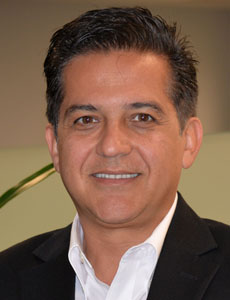Finding the Human-Technology Balance in WC Claims Technology: 6 Questions for Mitchell’s Shahin Hatamian

Where is the future of claims management headed?
Thanks to the COVID-19 pandemic, technologies and business practices, like remote work, that were once thought to be things of the future have become the norm earlier than anticipated, especially where technology is concerned.
Though, sectors like workers’ comp are still hesitant to embrace automated operations for fear of losing the human connection so desperately needed to help injured workers. Is that still possible to achieve in this new landscape?
Shahin Hatamian, senior vice president of product management and marketing at Mitchell International, looks to answer that question at an upcoming National Comp session on June 9 titled, “The Future of Technology in the Claims Process.” Hatamian sat down with Risk & Insurance® to discuss his presentation, and why he’s excited to share it.
Risk & Insurance®: When you developed this presentation, what was your goal? What do you want to share with the workers’ comp professionals who attend?
Shahin Hatamian: The session title is “The Future of Technology in the Claims Process.” First, I want to talk about the general state of automation, as a whole in the P&C industry before I get into the workers’ comp elements. I’ll delve into some examples of property insurance automation and share how companies in that segment are performing with automation for some simple claims.
I’ll talk about the auto physical damage and the work that’s being done in that space. As far as automation goes, I’ll discuss workers’ compensation and the contrast between workers’ comp and other segments of the P&C industry.
I want to investigate what tactics from those segments can be used in workers’ comp and which part of the workers’ comp claims process are too unique to apply some of those strategies to.
I want to draw attention to the fact that in the workers’ comp space, there are certain things that can be automated, but there’s still that need for human intervention and involvement when settling a claim. So really, we’re talking about touching the claim less versus being completely hands off with the claim and having a fully automated claims process.
R&I: Do you see that there are some segments where these new technologies are being used, but not others?
SH: Yes, that’s basically what I’ll be proposing: there are some segments that have more propensity for full automation, and workers’ comp doesn’t have as high of a propensity.
But, there are opportunities for automation along the way throughout various steps. The workers’ comp claim is complex and long in duration.
When you talk about a property claim where a single product was stolen or broken, it’s easier to assess the value of the product and assess the claim, potentially automatically. Whereas in a workers’ comp claim, you’re dealing with an individual who’s been injured on the job.
Healing can take, frankly more than a year. Sometimes they’re lifetime claims. You can’t settle that claim automatically and still enable them to return to normal life.
R&I: What do you hope attendees will take away from your presentation and share with their teams and partners?
SH: I really want attendees to understand this process is not an all or nothing proposition as far as automation for workers’ comp claims.
We’ve done some surveys and we know that there are certain carriers and workers’ comp service providers that have started implementing automation along their various steps of the claim lifecycle and they’re seeing the benefits of that.
But I would say a large majority are still very hesitant to try automation, because they feel like they would lose that control and that human touch, especially in a complex claim.
I want attendees to walk away knowing that there still is a large percentage of the claim, and then within that there’s a large percentage of steps within that lifecycle that can still be automated, without losing that oversight and supervision of an expert adjuster.
Claims adjusters can still experience very successful outcomes, but it’s just a matter of trying it and seeing that there are still gains to be had. I would call that successful to the furthest extent possible without going overboard.
Automating too much of the process has a negative drawback. If you go too far, you lose that human touch with the injured worker which is very important. But, automating a lot of routine and mundane tasks frees up the time for the adjusters and nurses to focus on what’s truly critical versus completing administrative tasks.
R&I: When you put it that way, do you find it makes it a little less intimidating for organizations to consider incorporating these kinds of technologies into their everyday operations?
SH: That’s really the whole crux of the presentation. Starting small is important and that’s also that last portion of the presentation: talking about examples for various components of the claims lifecycle management.
It’s about informing people and saying, ‘You can use this piece or that piece of automation,’ without going full force. That’s what I’m hoping to leave behind with the audience.
R&I: What makes you feel passionate about this? Why was it important to invest the time in sharing this information with those across the workers’ comp community right now?
SH: First, I believe the P&C space, but more specifically the workers’ comp space, is technology starved. When you compare that to other segments, like the financial sector, they’re at the forefront of technology usage, especially advanced technology.
Even within insurance, there are certain lines that are more automated. When you think of something like auto insurance, you can now have an app that the policyholders can use to buy and renew policies, measure driving capabilities and record accident damages.
There’s a lot of digital interaction that’s taking place between stakeholders. And I believe in the workers’ comp space, we’re still a bit behind.
However, you can’t avoid the technology moving forward. We’re living within a digital paradigm: whether it’s the consumer or an injured worker, everyone is used to working within a digital environment and utilizing our mobile phones for everyday tasks.
For the adjusters, their demographics are changing. Many are retiring and a new generation of adjusters are entering claims offices and they are familiar with this digital paradigm of interacting.
Not only that, the expertise of the previous generation is leaving with them as they retire. You need to capture that through the use of technology and automation, so that it’s available to the new generation of adjusters.
Lastly, because of COVID-19’s impacts on remote work, efficiency gains are becoming very important to companies. That is also something that is accelerating the need for automation and technology to make up for the gaps that COVID has created.
So, I think in the last few years, we’ve seen a lot more emphasis on technology in the insurance and workers’ comp space, but the pandemic is going to further accelerate its use moving forward to provide the tools necessary to handle claims.
R&I: It’s interesting how the pandemic’s impact forced adjusters to discover new modes of productive work that will now be used routinely post-pandemic. Is there anything you’d like to share with attendees?
SH: I just want to reiterate that it is very important for organizations to utilize technology and claims automation to supplement and improve human interaction, rather than replace it. There’s a good balance here to be had, it just takes a little initiative and openness to taking the first steps. &
 National Comp — the National Workers’ Compensation and Disability Conference — is back! We’re planning an in-person show for October, 20-22, 2021 and we’re excited to see everyone while still adhering to all safety protocols set forth by local and national health authorities at the time of the event. Register today!
National Comp — the National Workers’ Compensation and Disability Conference — is back! We’re planning an in-person show for October, 20-22, 2021 and we’re excited to see everyone while still adhering to all safety protocols set forth by local and national health authorities at the time of the event. Register today!
This year, we’ll feature seven tracks — from core content on medical and pharmaceutical management, claims and return-to-work, plus new and expanded avenues to explore like risk finance and injury prevention. All of our educational sessions are chosen for their ability to deliver sound takeaways and ideas that attendees can use right now.
In the meantime, National Comp will continue bringing you free virtual, educational content through our digital sessions series and our CompTalks program. Register today to make sure you don’t miss a digital session and check out our on-demand CompTalks library. Missed a session? Watch it here on-demand.











